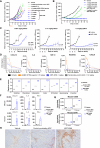XMT-2056, a HER2-Directed STING Agonist Antibody-Drug Conjugate, Induces Innate Antitumor Immune Responses by Acting on Cancer Cells and Tumor-Resident Immune Cells
- PMID: 40029253
- PMCID: PMC12010966
- DOI: 10.1158/1078-0432.CCR-24-2449
XMT-2056, a HER2-Directed STING Agonist Antibody-Drug Conjugate, Induces Innate Antitumor Immune Responses by Acting on Cancer Cells and Tumor-Resident Immune Cells
Abstract
Purpose: Targeted tumor delivery may be required to potentiate the clinical benefit of innate immune modulators. The objective of the study was to apply an antibody-drug conjugate (ADC) approach to STING agonism and develop a clinical candidate.
Experimental design: XMT-2056, a HER2-directed STING agonist ADC, was designed, synthesized, and tested in pharmacology and toxicology studies. The ADC was compared with a clinical benchmark intravenously administered a STING agonist.
Results: XMT-2056 achieved tumor-targeted delivery of the STING agonist upon systemic administration in mice and induced innate antitumor immune responses; single dose administration of XMT-2056 induced tumor regression in a variety of tumor models with high and low HER2 expressions. Notably, XMT-2056 demonstrated superior efficacy and reduced systemic inflammation compared with a free STING agonist. XMT-2056 exhibited concomitant immune-mediated killing of HER2-negative cells specifically in the presence of HER2-positive cancer cells, supporting the potential for activity against tumors with heterogeneous HER2 expression. The antibody does not compete for binding with trastuzumab or pertuzumab, and a benefit was observed when combining XMT-2056 with each of these therapies as well as with trastuzumab deruxtecan ADC. The combination of XMT-2056 with anti-PD-1 conferred benefit on antitumor activity and induced immunologic memory. XMT-2056 was well tolerated in nonclinical toxicology studies.
Conclusions: These data provide a robust preclinical characterization of XMT-2056 and provide rationale and strategy for its clinical evaluation.
©2025 The Authors; Published by the American Association for Cancer Research.
Conflict of interest statement
R.A. Bukhalid reports a patent for Mersana Therapeutics and holds patents and patent applications relevant to this work pending, issued, and licensed to various institutions. J.R. Duvall reports personal fees from Mersana Therapeutics outside the submitted work; in addition, J.R. Duvall has a patent for ADCs comprising STING agonists pending. K. Lancaster reports other support from Mersana Therapeutics outside the submitted work. K.C. Catcott reports other support from Mersana Therapeutics outside the submitted work and is employed by Mersana Therapeutics. N. Malli Cetinbas reports personal fees and other support from Mersana Therapeutics during the conduct of the study; in addition, N. Malli Cetinbas has a patent for Mersana Therapeutics pending and issued. J.D. Thomas reports personal fees from Mersana Therapeutics outside the submitted work; in addition, J.D. Thomas has a patent for Mersana Therapeutics and holds patents and patent applications relevant to this work pending. L. Xu reports a patent for W02021202984A1 issued and licensed to Mersana Therapeutics. D. Toader reports a patent for certain pending patent applications and granted patents pending. M. Damelin reports a patent for Mersana Therapeutics and holds patents and patent applications relevant to this work pending. T.B. Lowinger reports other support from Mersana Therapeutics outside the submitted work; in addition, T.B. Lowinger has various patents pending and issued to Mersana Therapeutics. No disclosures were reported by the other authors.
Figures






References
MeSH terms
Substances
Grants and funding
LinkOut - more resources
Full Text Sources
Medical
Research Materials
Miscellaneous

